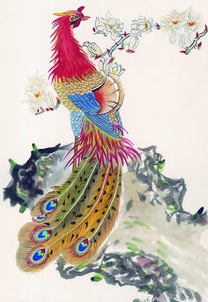 Recently, I’ve developed an interest in mythology as the imaginative representations of cultural beliefs and ideals. Beautiful pictures and stories from across the globe fascinate me, but currently, none more than the myth of the Fenghuang, or Chinese “phoenix”. Due to millennia of Fenghuang mythology, the creature’s symbolism is sometimes conflicted. But here is what I’ve gathered and why I think it matters for contemporary American women… The Fenghuang is part of ancient Chinese cosmology and was responsible along with three other mythological creatures for the creation of the world. After these creatures had created our world, they divided it into four sectors of north, south, east, and west, each taking dominion over one. The Fenghuang’s domain was the south and as a result, the summer. This mythological creature’s body symbolizes the six celestial bodies with its head as the sky, eyes as the sun, back as the moon, wings as the wind, feet as the earth, and finally, tail as the planets. The actual physical appearance of the Fenghuang is a composite of many different animals. The creature is made up of the beak of a cock, the face of a swallow, the forehead of a fowl, the neck of a snake, the breast of a goose, the back of tortoise, the hindquarters of a stag, and the tail of a fish. This sounds like quite the odd looking creature to me, but interestingly enough, artistic depictions of the Fenghuang never seem to show the bird’s described physical make-up. Instead it is depicted as a beautiful and graceful composite of many bird varieties, most often with a peacock tail with feathers made of the five fundamental colors black, red, green, white, and yellow (corresponding to the five elements of water, fire, wood, metal, and earth). In China’s most ancient mythology, the Fenghuang was actually two birds united together. Feng represented the male entity and huang the female. United together to create the Fenghuang, they were a metaphor of the yin and yang, as well as the sacred union of male and female. Used to symbolize peace and harmony, the Fenghuang was said to appear only at the beginning of a new era or at the ascension to the thrown of a benevolent ruler. More recently in China’s long history, though, the Feng and Huang have been merged into one female creature, the Fenghuang, so that the ancient mythological figured could be paired with the male dragon as a symbol for the empress and emperor. In more recent centuries, the dragon and phoenix are often seen paired together as a symbol for marriage and unity. What draws me to the Fenghuang is a particular ancient description of its symbolism. In the Shan Hai Jing (山海经), a classic of Chinese mythology, each part of the Fenghuang’s body symbolizes a word. The head represents virtue (德), the wings represent duty (義), the back represents propriety (禮), the abdomen represents belief (信), and the chest represents mercy (仁). What a beautiful symbol for femininity! When I think about contemporary American culture, it’s hard for me to come up with any myths as deep symbols for femininity. We have larger than life caricatures of women as sex toys, power-hungry achievers, or spineless and wimpy prey, but there is a fundamental difference between myth and caricature. Caricature is based on what people perceive to exist. Myth presents what people want to be. The beauty of mythology is that it takes us beyond reality and gives us a chance to create an ideal. What does it say about us women if we do not have any collective symbols beyond our reality to remind us of what we hope to become? If I could pick a mythological symbol to inspire modern women, I would pick the Fenghuang. The creature flies with beauty and strength, ushering in times of peace and harmony. It is virtuous as it carries out its duty. Representing a life filled with belief (I would add, belief in something bigger than itself), the Fenghuang is marked by mercy and compassion. Lastly, the Fenghuang symbolizes propriety, a lost word in contemporary times. But the word has richer meaning than its surfaces usage. In addition to referring to manners of behavior, propriety means “appropriateness to the purpose or circumstances” and “rightness or justness.” Who could argue that justness and an understanding of one’s circumstances are a beautiful component of feminine ideals? I wish our society would dream again and intrigue us with its ideals. ~Hannah
0 Comments
Leave a Reply. |
Archives
October 2018
Categories
All
|
